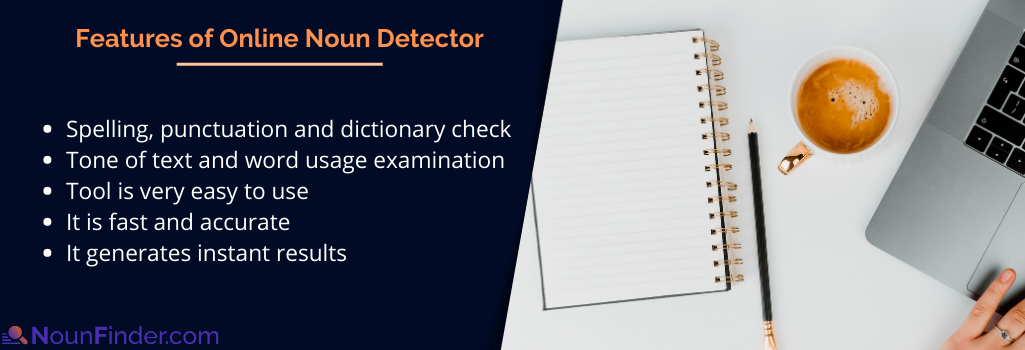Our noun finder is an online tool that is used for identifying nouns in sentences as well as other parts of speech used in English grammar. In addition to serving as a parts of speech checker, it informs the user whether the nouns and other parts of speech are being used as they should be. If not, it provides suggestions on how to correct the errors. Using nouns and the other parts of speech in a grammatically correct way isn’t just important to students. Business people, writers, bloggers, journalists and anybody else who communicates via the written word must be able to provide grammatically correct text. A tool for noun verb detection that points out grammar mistakes and advises how to fix them is invaluable to anybody who writes.
Nouns That Can Be Checked With Our Noun Detector
Nouns are one of the first parts of speech we are taught when learning English grammar. A noun is a word used to identify people, places and things. The following are the 10 types of nouns used in English grammar:

- Common nouns. Common nouns are the names of people, places or things that are non-specific. Example: “I took my dog for a walk.”(dog is a thing), “I rowed across the lake.” (lake is a place).
- Proper noun. A proper noun is a specific name for a person, place or thing. Example: “George and I went to the party.” (George is a person), “I visited Miami during my vacation.” (Miami is a place), “I bought my television from Walmart.” (Walmart names a thing).
- Concrete nouns. A concrete noun is something that can be perceived through at least one of the five senses ( sight, smell, sound, taste, touch). Example: “Mary ate the pie.” (pie can be seen, tasted, smelled and touched)
- Abstract nouns. Abstract nouns refer to intangible ideas such as emotions, character traits and social concepts. Example: “It was my anger that caused me to punch the wall.”
- Collective nouns. Collective nouns describe a group of people or things. Depending on how it is used a collective noun can be singular or plural. Example: “Our team practices daily.” (team as singular), “The teams competed against each other.” (team as plural)
- Compound nouns. Nouns that are formed from two or more words are known as compound nouns. Sometimes the compound noun uses a space between two words such as ice cream. A compound word may be made up of two nouns (basketball), a noun and a verb (sunrise) or an adjective and a noun (highway).
- Countable nouns. Countable nouns are things/people that can be counted no matter how high the number. Example: “There are 6 chairs at the table” (number + chairs). “I had an apple for breakfast.” (indefinite article “an” + apple)
- Uncountable nouns. Sometimes known as a mass noun, an uncountable noun is something that can’t be counted. Salt, advice and garbage are examples of uncountable nouns.
- Possessive nouns. Possessive nouns are nouns that show possession or ownership and are often formed by adding an apostrophe s to a common or proper noun. Example: “George’s car ran out of gas.” “The girl’s bike was stolen.”
- Plural nouns. Plural nouns are nouns that refer to more than one person, place or thing. They are most commonly formed by adding “s”, “ies”, or “es” to the end of a common noun. Example: dogs, boys, tables.
There are numerous rules that apply to using the different types of nouns which is why our noun detector tool is so useful. Verbs may need to be changed depending on the type of noun being used and a verb noun agreement checker can keep you from making grammatical errors in sentences. You may think you don’t need a proper noun checker or a common noun checker when proofreading but that just scrapes the surface of noun usage. Do you know how to recognize a dependent clause? Many people don’t but our noun clause identifier does. It identifies all the nouns in your text as well as noun phrases and informs you if they are being used correctly. In addition the noun phrase tester provides suggestions on how to fix incorrect noun usage.
Tips and Tricks for Using Our Proper Noun Checker Correctly
There are numerous rules for the proper use of nouns in English grammar and most people don’t remember all of them. The following are 7 tips/secrets to help you use nouns correctly in your paper and other text.
- To test whether a word is a countable noun or uncountable noun put test it by putting “a”, “an” or a number before the word. If “a”, “an” or a number can be used it’s a countable noun. If not then it is an uncountable noun.
- If a noun is plural or already ends in an “s” just add an apostrophe after the “s” to show possession. Ex: “Where is the boys’ restroom?”
- Take a break before proofreading: You need some time to distance yourself from your text before proofreading for proper noun usage. When you proofread too soon your eyes sometimes see what your mind expects to see and not what is actually there.
- Two possessive nouns joined by the word “and” denote plural while two nouns joined by the word “and” and only one is possessive denotes singular. Ex: “John’s and Peter’s fathers are going to the meeting.”(plural 2 fathers”) “John and Peter’s father is going to the meeting.”(singular, 1 father)
- Read your text out loud: When you read your text out loud you will often catch mistakes that you miss when just reading to yourself.
- Keep a dictionary and grammar book handy: It can be time consuming but having a dictionary and grammar rule book at your fingertips allows you to check words and phrases you are unsure of, especially for non-native English speakers.
- Use our online noun identifier: Use our writing tool to find nouns in a sentence online quickly and ensure proper usage. Our parts of speech finder online identifies the different parts of a sentence, indicates incorrect usage and makes suggestions on how to fix errors in your text
Proofreading and editing text for noun misuse and other grammatical errors on your own is a time consuming process. It can take hours and you still may overlook some mistakes. Our noun clause finder can show you any noun misuse and other mistakes in a matter of seconds and make suggestions on how to correct your mistakes, shaving hours off the editing process, while improving the final text you submit. Our tool does not get tired so it will always find the issues that it is programmed to find.
Additional Features of Our Noun Checker
Our noun/pronoun agreement fixer isn’t limited to performing only a single task. Sure, it works great as a possessive noun checker or for identifying and correcting noun misuse and other grammatical errors but it also does much more.
- Additional functions include a spelling checker, punctuation checker and dictionary checker.
- It can also determine whether you are writing in active or passive voice and make suggestions to improve your text so that you use the appropriate voice to deliver your message. On top of all that it examines the tone of your text and word usage.
- The tool is easy to use. Just copy and paste your text into the provided field and click the button to initiate text analysis. Within a short time you will receive a report that identifies any errors in your text, as well as suggested adjustments and corrections. You dont have to follow the suggestions that the tool makes, you can always make adjustments as you see fit to follow your own writing style. Of course, always run your text through our powerful tool once more once you have made your changes to avoid any errors.
- It is fast and accurate, and as an added bonus your own grammar skills will improve as you learn how to identify mistakes as well as correct them. You will never have to ask yourself how to find my predicate noun again because our writing tool will do it for you and teach you how in the process.

Our noun detector/corrector is fast, easy to use and accessible online 24/7. It provides accurate results quickly and is free to use. With its many features it is the perfect tool to help you edit your academic papers or any other text.




